Page 1
Page 2
Page 3
Page 4
Page 5
Page 6
Varroacides Methods
Bayvarol: (95% success rate)
These are Plastic strips containing bayvarol, they are hung between the brood frames, and the chemical is spread by contact with the strip and other bees. It is used in the autumn or early spring for 6 weeks. It is safe to use during the honey flow.
Effective, but mites in the southwest and other areas of the UK have become resistant.
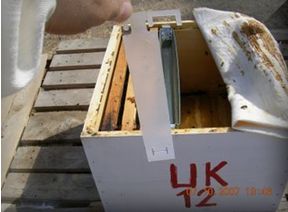
A Bayvarol Strip
Apistan: (95% success rate)
These are also Plastic strips hung between the brood frames and the Apistan is then spread by contact with the strip and other bees. Identically to Bayvarol, it should be used in the autumn or early spring for 6 to 8 weeks and is safe for use during the honey flow.
However, again like Bayvarol, whilst Apistan is mostly effective, unfortunately mites in the southwest and other areas of the UK have become resistant.
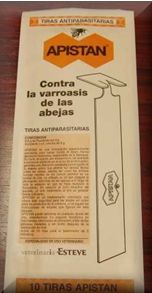
Apistan Strips
It is also known that the active ingredients of both Apistan and Bayvarol (synthetic pyrethroids) are absorbed into the bees wax. Recent research has found that the chemicals affect the drones as they develop surrounded by the wax and this is also the case with queens. This suggests that synthetic pyrethroid based products could be having detrimental affects on queen rearing and the rest of the colony.
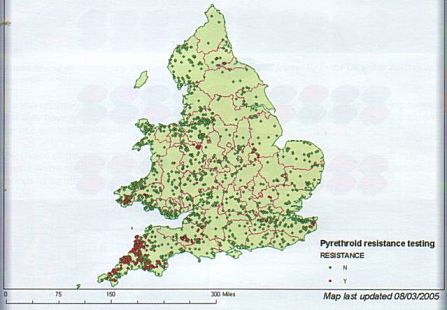
A map showing cases of confirmed pyrethroid resistance in England and Wales (as of March 2005). It has since become much more commonplace.
Apiguard: (90-95% success)
This is a slow release gel with two 50g pack treatments, it is spread by contact, evaporation and ingestion. Place the opened tray on top of the brood frames and replace the crown board. Use it in the spring or late summer after the honey harvest.
Efficient with optimum conditions, it can depend on bee activity and the temperature, and is best used with a varroa floor in and crown board vents covered.
It contains Thymol and cannot be used during the honey flow because it will taint the honey.
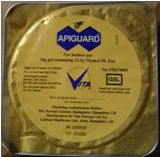
Apiguard Tray
Oxalic Acid: (90% success)
An acid solution trickled over the combs of bees, usually 2.5ml per brood comb, it is spread by bee contact. Use it in the winter and during broodless periods, because it could damage young immature bees in the cell.
There is a danger of colony weakening and best applied during the winter, usually December or January.
Cannot use during any honey flow as it is highly toxic. Always be sure to use protective equipment.
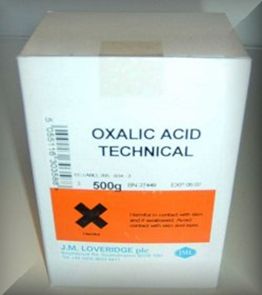
Oxalic Acid (can be purchased diluted and with a syringe)
To continue to Page 6, please click here...